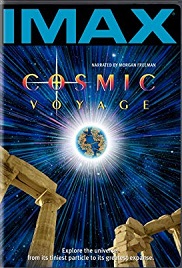The “Cosmic Voyage” taken in the film contains “landmarks” to enable the viewer to keep in mind the scale of things in the universe in terms of powers of ten. The journey has two major thresholds: first, the point at which stars begin to be seen in groups, at 1015 meters, and second, when the same thing happens with galaxies, several powers of ten later, at 1023 meters.
There is a fundamental difference between these two scales: the distances between stars are huge with respect to their sizes. There are, for example, about one million diameters of the Sun between the Sun and its closest stellar neighbor, Alpha Centauri. It can be said that space within galaxies is virtually empty, except, of course in their very dense centers, where there is evidence for supermassive black holes attracting huge amounts of matter to themselves. Galaxies on the other hand are proportionally very close to each other, on a scale of 25 to 1, where 1 is an average size of a galaxy. It is therefore frequent to see galaxies interacting and colliding, while stars within the galaxies hardly ever do so, not even when two galaxies smash into each other: the stars fly by each other like two swarms of mosquitoes. What smashes, in a collision between galaxies, is their interstellar dust and gas.
There are more visual presentations of galaxy interactions at: Interacting Galaxies from COSMOS – The SAO Encyclopedia of Astronomy.
Interacting Stars
That there are hardly any collisions between stars does not mean that stars do not interact. When star formation occurs in a gas cloud, the formed stars are gravitationally bound to each other. Sometimes a large number of them stay together as a cluster of stars, and as many as 85% of the stars in the Milky Way Galaxy are in fact binary stars, triplets or multiple systems.
There is a minimum mass required before a lump of gas coalesces to become a star. This has been estimated to be between 40 and 80 times the mass contained in Jupiter. In other words, if Jupiter had accumulated about that many times its actual mass when the solar system was formed, it would now be a binary system. Such a situation was imagined in the Star Wars universe, where Luke Skywalker’s planet Tatooine has two suns. But would a binary star system be able to have planets in stable orbits, and would living beings be able to experience a double sunset? It seems to have been proven theoretically and observed in practice. Learn more about it at Ask an Astrophysicist.
A frequent and well-studied case is that of two interacting stars where one of them is a compact white dwarf star or the collapsed remnant of a star that has ceased to emit energy in the form of heat and light through thermonuclear reactions. The other is a still active star. The collapsed companion has very strong gravity and absorbs huge amounts of gas from the active star. In the case of a white dwarf being the compact companion, the infalling material can trigger a supernova of the type known as Ia (roman numeral “I” and the letter “a”). These supernovae have been very important for astrophysicists over the last decade, because they are known to have a very precise luminosity, and can therefore be used as “standard candles” to determine the distances of the galaxies in which they occur: since it is known how bright they always are, the fainter they become, the further away they are. This in turn has allowed astronomers to discover that the expansion of the universe is not only not slowing down (as would be expected due to the mutual gravitational attraction of all objects in it) but in fact it is speeding up! The still mysterious origin of this acceleration of the universe’s expansion has been named “dark energy.” Find out more about supernovae Ia and dark energy at Dark Energy at Hubble Discoveries and the links therein.
Galaxies and the Large Scale Structure of the Universe
As mentioned above, galaxies do interact and collide. Quite often, in fact. Galaxies come in different shapes, the two main types being “spiral” galaxies and “elliptical” galaxies. The “spiral” shape is usually interpreted as a whirlpool of stars, gas and dust falling into a supermassive black hole at the center. The “elliptical” shape is believed to be related to the common occurrence of galaxy collisions: after two (spiral) galaxies smash into each other, the gas, dust and stars are mixed together and stripped off their spiral shape to finally clump into a featureless and more or less elliptical agglomeration.
Their distances are relatively small, at a scale of 1:25 with respect to their size. This means that the Milky Way Galaxy being about 100,000 light years across, typical distances to other galaxies are 2.5 million light years. A huge distance, but relatively close in astronomical scales.
Like stars, galaxies can be found in clusters, but astronomers surveying the universe are finding that these clusters are not evenly distributed over space. Instead, they build a large scale structure of the universe, with large “filaments” made of millions of galaxies and clusters of galaxies. The formation of this structure from a smooth distribution of matter at early stages of the universe is being studied and simulated with computers by astronomers. Videos and stills of these simulations can be found at: Formation of the large-scale structure in the Universe: filaments from the University of Chicago.
The Known Universe Scientifically Rendered For All to See is a breathtaking video with the whole known universe has been made by the American Natural History Museum. Everything in it is based in real data, it is not a filmmaker’s rendering of what is imagined out there: every object in the sequence has been detected and catalogued by astronomers.


